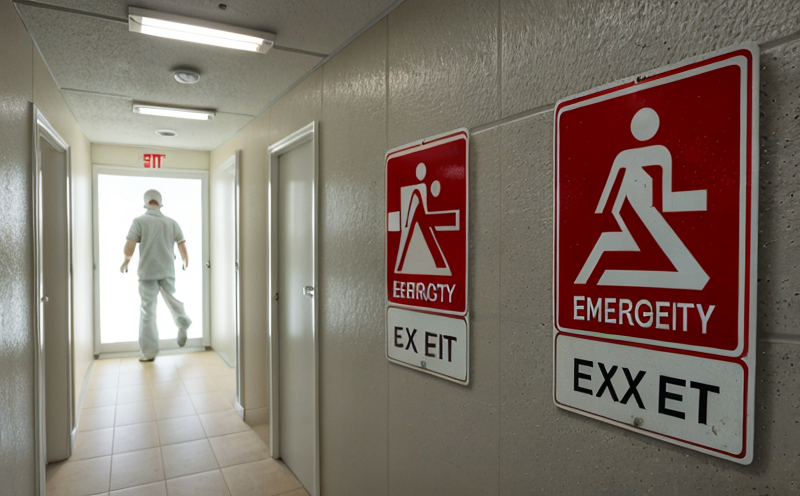NFPA 101 Life Safety Code Emergency Lighting Testing
The National Fire Protection Association (NFPA) NFPA 101: Life Safety Code is a leading standard that sets the minimum requirements for providing safe, accessible, and functional buildings. One of the critical components underpinning NFPA 101 compliance is emergency lighting and exit signs testing. This service ensures that in the event of an emergency, occupants can safely evacuate from any building.
The primary goal of this service is to ensure that emergency lighting fixtures are capable of providing sufficient light to guide people through a building during power outages or other emergencies. These tests follow strict protocols and standards set by NFPA 101, which require regular inspections and testing to verify the integrity and functionality of these systems.
Emergency lighting systems typically consist of battery-powered fixtures that activate when the main power supply is interrupted. Proper functioning ensures that occupants can navigate safely towards exits or designated safe areas. The testing process involves several steps designed to simulate real-world conditions, ensuring that all components work as intended under stress scenarios.
The NFPA 101 requires specific performance criteria for emergency lighting systems, including both visual and functional aspects. Visual checks ensure that the signs are visible from a distance during an evacuation, while functional assessments verify that each light source operates correctly when activated by a power failure signal or manual switch.
Our service begins with a thorough inspection of existing emergency lighting installations to identify any potential issues before conducting tests. During this phase, we examine fixtures for proper installation, ensure there are no obstructions obstructing the pathway, and verify that all signs meet regulatory requirements regarding size, color, and placement.
Once initial inspections are complete, our team proceeds with functional testing using industry-standard equipment capable of simulating various failure modes. For battery-powered systems, we replicate power outages to confirm that backups activate promptly; for photoelectric sensors, we assess sensitivity levels against specified thresholds.
Data collected during these tests is analyzed according to established criteria outlined in NFPA 101, allowing us to evaluate whether each system meets the necessary standards. Any discrepancies from expected behavior are documented along with recommendations for corrective actions if needed.
After completing all testing procedures, we generate detailed reports summarizing findings and conclusions drawn from our analysis. These documents serve as valuable resources both for internal records management purposes and external audits conducted by regulatory bodies or clients themselves.
Applied Standards
The NFPA 101 Life Safety Code mandates compliance with several specific sections related to emergency lighting systems, including:
- NFPA 101: Section 7.9.3 - Emergency Lighting Systems
- NFPA 101: Section 8.4.6 - Exit Signs and Markings
- NFPA 101: Section 9.2.1 - Photoluminescent Signage
These sections provide detailed guidelines on how to properly design, install, maintain, and test emergency lighting systems within buildings. By adhering strictly to these regulations, organizations can help ensure their facilities are prepared for emergencies while also protecting against potential legal liabilities associated with non-compliance.
In addition to NFPA 101, other relevant standards may apply depending on local regulations or organizational policies. For instance, ISO 9001:2015 focuses on quality management systems, which could be beneficial for organizations looking to integrate these testing practices into their broader operations framework.
Customer Impact and Satisfaction
Regular NFPA 101 compliant emergency lighting tests have numerous positive impacts on organizations, impacting both safety and operational efficiency:
- Increased Safety: Reliable emergency lighting reduces risks associated with unlit pathways during critical moments.
- Improved Compliance: Ensures adherence to industry best practices as outlined in NFPA 101, reducing potential legal issues.
- Enhanced Reputation: Demonstrates commitment to employee and public safety, enhancing overall reputation among stakeholders.
Our clients often report increased peace of mind knowing that their facilities meet stringent regulatory requirements. Additionally, they appreciate the detailed reports we provide as tools for ongoing maintenance planning and strategic decision-making.
Competitive Advantage and Market Impact
In today's competitive environment, having a reputation for safety can be a significant differentiator in attracting new clients or retaining existing ones. Organizations that prioritize NFPA 101 compliance demonstrate leadership qualities valued across industries. This commitment to excellence sets them apart from competitors who may not invest equally in such initiatives.
Furthermore, by staying ahead of regulatory changes and best practices, these organizations position themselves as industry leaders capable of adapting swiftly to evolving challenges. Their proactive approach fosters trust among customers, investors, and other key stakeholders, ultimately contributing positively to their market standing.





